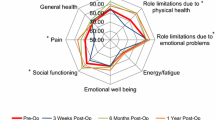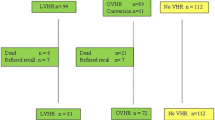Abstract
Background
An incisional hernia is a frequent complication of abdominal surgery. The repair of incisional hernias comes with a high risk of reherniation and serious complications. With the introduction of mesh repair, recurrence rates have decreased and subsequent clinical outcomes have improved. Whereas further research needs to be done to improve complication rates and recurrence, the focus has now been placed on quality-of-life outcomes in patients undergoing these repairs. The aim of this study was to investigate the long-term health-related quality of life (HRQL) of patients who were treated for incisional hernias using an onlay technique.
Patients and methods
Over a period of 10 years (1997–2007), 101 patients with an incisional hernia were treated with an onlay marlex mesh, fixed on the fascia with skin staples. Of the 101 patients, there were 45 males and 56 females, and their mean age was 55 years. Nine patients died and 13 were lost during follow-up. Of the remaining 79 patients, eight refused to participate. The mean follow-up time was 64 months (normal distribution, standard deviation [SD] 35 months). The Short Form 36 (SF-36©) and the Karnofsky Performance Status Scale (KPS) and a semi-structured interview were used to measure HRQL.
Results
Seventy-one of the 101 patients were evaluated at our out-patient clinic. Twenty-one patients (20%) had an open-abdomen treatment in their medical history. The median admission time was 4.5 days (quartiles 3–6.25). The mean follow-up time was 64 months (SD 35 months). A seroma was reported in 27 of the 101 patients (27%) and a wound infection in 22 patients (21%), of which five patients had to be re-operated. Only if a patient was evaluated at our out-patient clinic could reherniation be scored; this occurred in 11 of 71 patients (16%). The evaluation of HRQL showed equal SF-36© scores for patients treated for an incisional hernia compared to their matched controls. Patients with a history of an open-abdominal treatment did not score significantly lower compared to patients without such a treatment. The median KPS score was 75, indicating that activities could be performed with effort and patients had some signs of disease.
Conclusion
HRQL is the same in patients treated for an incisional hernia compared to the matched controls. Therefore, the onlay technique seems to be an acceptable method to repair large incisional hernias.
Similar content being viewed by others
References
Cassar K, Munro A (2002) Surgical treatment of incisional hernia. Br J Surg 89:534–545
Kingsnorth A, LeBlanc K (2003) Hernias: inguinal and incisional. Lancet 362:1561–1571
den Hartog D, Dur AH, Tuinebreijer WE, Kreis RW (2008) Open surgical procedures for incisional hernias. Cochrane Database Syst Rev 3:CD006438
Nieuwenhuizen J, Kleinrensink GJ, Hop WC, Jeekel J, Lange JF (2008) Indications for incisional hernia repair: an international questionnaire among hernia surgeons. Hernia 12:223–225
Urbach DR (2005) Measuring quality of life after surgery. Surg Innov 12:161–165
Wright JG (1999) Outcomes research: what to measure. World J Surg 23:1224–1226
Heniford BT, Walters AL, Lincourt AE, Novitsky YW, Hope WW, Kercher KW (2008) Comparison of generic versus specific quality-of-life scales for mesh hernia repairs. J Am Coll Surg 206:638–644
Luijendijk RW, Hop WC, van den Tol MP, de Lange DC, Braaksma MM, IJzermans JN et al (2000) A comparison of suture repair with mesh repair for incisional hernia. N Engl J Med 343:392–398
de Vries Reilingh TS, van Geldere D, Langenhorst B, de Jong D, van der Wilt GJ, van Goor H et al (2004) Repair of large midline incisional hernias with polypropylene mesh: comparison of three operative techniques. Hernia 8:56–59
Korenkov M, Paul A, Sauerland S, Neugebauer E, Arndt M, Chevrel JP et al (2001) Classification and surgical treatment of incisional hernia. Results of an experts’ meeting. Langenbecks Arch Surg 386:65–73
Korenkov M, Sauerland S, Arndt M, Bograd L, Neugebauer EA, Troidl H (2002) Randomized clinical trial of suture repair, polypropylene mesh or autodermal hernioplasty for incisional hernia. Br J Surg 89:50–56
Burger JW, Luijendijk RW, Hop WC, Halm JA, Verdaasdonk EG, Jeekel J (2004) Long-term follow-up of a randomized controlled trial of suture versus mesh repair of incisional hernia. Ann Surg 240:578–583
Velanovich V (2001) The quality of quality of life studies in general surgical journals. J Am Coll Surg 193:288–296
Kriwanek S, Armbruster C, Dittrich K, Beckerhinn P, Schwarzmaier A, Redl E (1998) Long-term outcome after open treatment of severe intra-abdominal infection and pancreatic necrosis. Arch Surg 133:140–144
Scheingraber S, Kurz T, Dralle H (2002) Short- and long-term outcome and health-related quality of life after severe peritonitis. World J Surg 26:667–671
van Hanswijck de Jonge P, Lloyd A, Horsfall L, Tan R, O’Dwyer PJ (2008) The measurement of chronic pain and health-related quality of life following inguinal hernia repair: a review of the literature. Hernia 12:561–569
Aaronson NK, Muller M, Cohen PD, Essink-Bot ML, Fekkes M, Sanderman R et al (1998) Translation, validation, and norming of the Dutch language version of the SF-36 Health Survey in community and chronic disease populations. J Clin Epidemiol 51:1055–1068
Visschers RG, Olde Damink SW, van Bekkum M, Winkens B, Soeters PB, van Gemert WG (2008) Health-related quality of life in patients treated for enterocutaneous fistula. Br J Surg 95:1280–1286
Bitzer EM, Lorenz C, Nickel S, Dörning H, Trojan A (2008) Patient-reported outcomes in hernia repair. Hernia 12:407–414
Kriegsman DM, Deeg DJ, Stalman WA (2004) Comorbidity of somatic chronic diseases and decline in physical functioning: the Longitudinal Aging Study Amsterdam. J Clin Epidemiol 57:55–65
Kriegsman DM, Deeg DJ, Van Eijk JT, Penninx BW, Boeke AJ (1997) Do disease specific characteristics add to the explanation of mobility limitations in patients with different chronic diseases? A study in the Netherlands. J Epidemiol Community Health 51:676–685
Conze J, Kingsnorth AN, Flament JB, Simmermacher R, Arlt G, Langer C et al (2005) Randomized clinical trial comparing lightweight composite mesh with polyester or polypropylene mesh for incisional hernia repair. Br J Surg 92:1488–1493
Dietz UA, Hamelmann W, Winkler MS, Debus ES, Malafaia O, Czeczko NG et al (2007) An alternative classification of incisional hernias enlisting morphology, body type and risk factors in the assessment of prognosis and tailoring of surgical technique. J Plast Reconstr Aesthet Surg 60:383–388
Winkler MS, Gerharz E, Dietz UA (2008) Overview and evolving strategies of ventral hernia repair. Urologe A 47:740–747
Author information
Authors and Affiliations
Corresponding author
Rights and permissions
About this article
Cite this article
Poelman, M.M., Schellekens, J.F., Langenhorst, B.L.A.M. et al. Health-related quality of life in patients treated for incisional hernia with an onlay technique. Hernia 14, 237–242 (2010). https://doi.org/10.1007/s10029-009-0619-6
Received:
Accepted:
Published:
Issue Date:
DOI: https://doi.org/10.1007/s10029-009-0619-6




